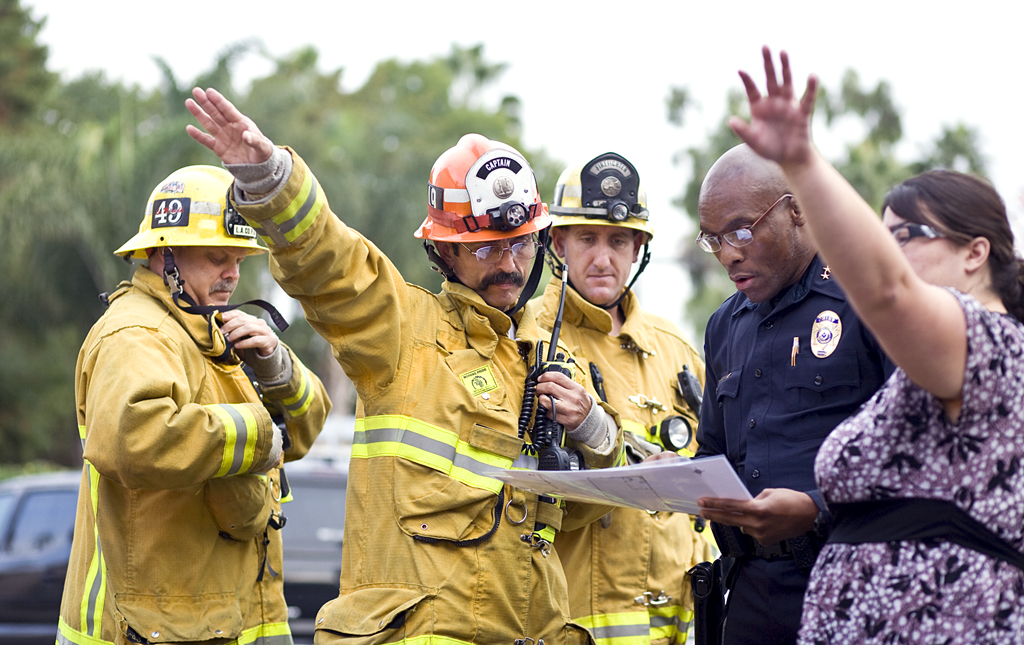As part of the Great California ShakeOut, La Mirada held its annual earthquake drill at Biola’s Facilities Services building last Thursday.
“Every year they choose a specific location,” said Carissa Brooks, emergency operations manager for Campus Safety. “This year, they chose us. It’s exciting for us.”
Participating alongside the city
In past years, Biola participated in the state-wide ShakeOut by holding emergency preparedness meetings and having practice dorm evacuations. Such activities were done with little contact with the city, but, this year, Biola held an actual drill side-by-side with the city.
“It’s different being able to work with outside agencies,” Brooks said. “Communicating, building that relationship; that aspect is really huge. We have a strong working relationship [with the city, but the] fire department, we don’t have them come out as often.”
Working with other teams
“It gives us a chance to work with their emergency response team in a real type situation,” said Justin Shelby, public information officer for Campus Safety. “We learn an awful lot just from the way they handle the disaster.”
Held on the morning of Oct. 21, the drill involved Campus Safety, Biola staff and La Mirada emergency response teams acting as they would if a 7.8 earthquake occurred. Volunteers planted in the Facilities building pretended to have been injured and trapped by an earthquake, and Campus Safety employees, city response teams and the La Mirada fire department responded to the scene with medical assistance and search and rescue. The inside of the Facilities building was also prepped to appear and sound like a real earthquake had happened, Shelby said.
Simulating realistic appearances
“It was a lot more realistic than I expected it to be,” Shelby said. “They did a lot of work trying to make it look like there’d actually been an earthquake, sound effects, lighting. It looked kind of like a disaster area.”
Shelby said the broad purpose of having such a realistic drill is emergency preparedness. Brook’s position came out of Campus Safety’s decision to focus on preparedness.
“The better Campus Safety can do its job, the more students can focus on being students,” Shelby said. “This is also a good opportunity to put the focus on what are you, yourself, going to do during an emergency. It’s so we can come up with a good plan.”
Planning for emergency
Although such plans are never set in stone, Campus Safety has made a continual effort to have plans, or guidelines and checklists, as Shelby called them, in place to give them a place to start and to remind them of their job in the event of a real emergency.
Campus Safety chief John Ojeisekhoba said Campus Safety employees receive “tactical map books” that give them such guidelines. Campus Safety has also partnered with Auxiliary Services and Facilities Services to buy three storage sheds for emergency supplies. According to Brian Phillips, senior director of operations for Facilities Services, the sheds cost about $25,000 each. One shed contains three days worth of food and water supply that won’t expire for another five years. Campus Safety calculated how many students would stay on campus in the event of an earthquake, Ojeisekhoba said, and purchased $11,000 worth of food, about 3,000 meals ready to eat.
The other sheds contain about $13,000 worth of supplies, Ojeisekhoba said. The second shed contains Facilities supplies such as regenerators, power tools and lanterns that can be used in major situations such as an earthquake or a power outage like the one that occurred last spring. The third shed has supplies for the Health Center that include IV bags, bandages, wheelchairs, stretchers, and other medical supplies.
Such supplies would be needed if a high magnitude earthquake occurred, an event which Brooks said is highly possible.
Keeping Biola safe
Brooks said last week’s drill was an important part of keeping Biola safe, especially in light of Biola’s earthquake-prone location.
“A lot of people have never been in an earthquake,” Brooks said. “The reality of being in one in four years at Biola is pretty big. We’re not taking this lightly.”
According to Brooks, a magnitude 7.8 earthquake is more than likely in the next 30 years.
“You’d be silly to think that it’s not going to happen at some time,” she said. “The reality of an earthquake hitting in our lifetime is something [scientists] are all virtually convinced of.”
Southern California lies on top of several faults, including the San Andreas fault. According to a 2007 Southern California Earthquake Center forecast, California has a 99.7 percent chance of having an earthquake with a magnitude of 6.7 or higher in the next 30 years. The likelihood of an earthquake of magnitude 7.5 or higher in the next 30 years is 46 percent.
Thanks to drills like the one Biola hosted last week, Campus Safety would be prepared if a major earthquake shook Biola.
Shelby said he was pleased with how the drill went overall.
“It went really well,” he said. “We had good participation both from our staff, La Mirada public safety, and other agencies.”







